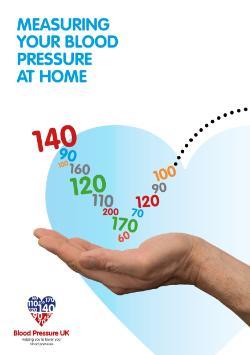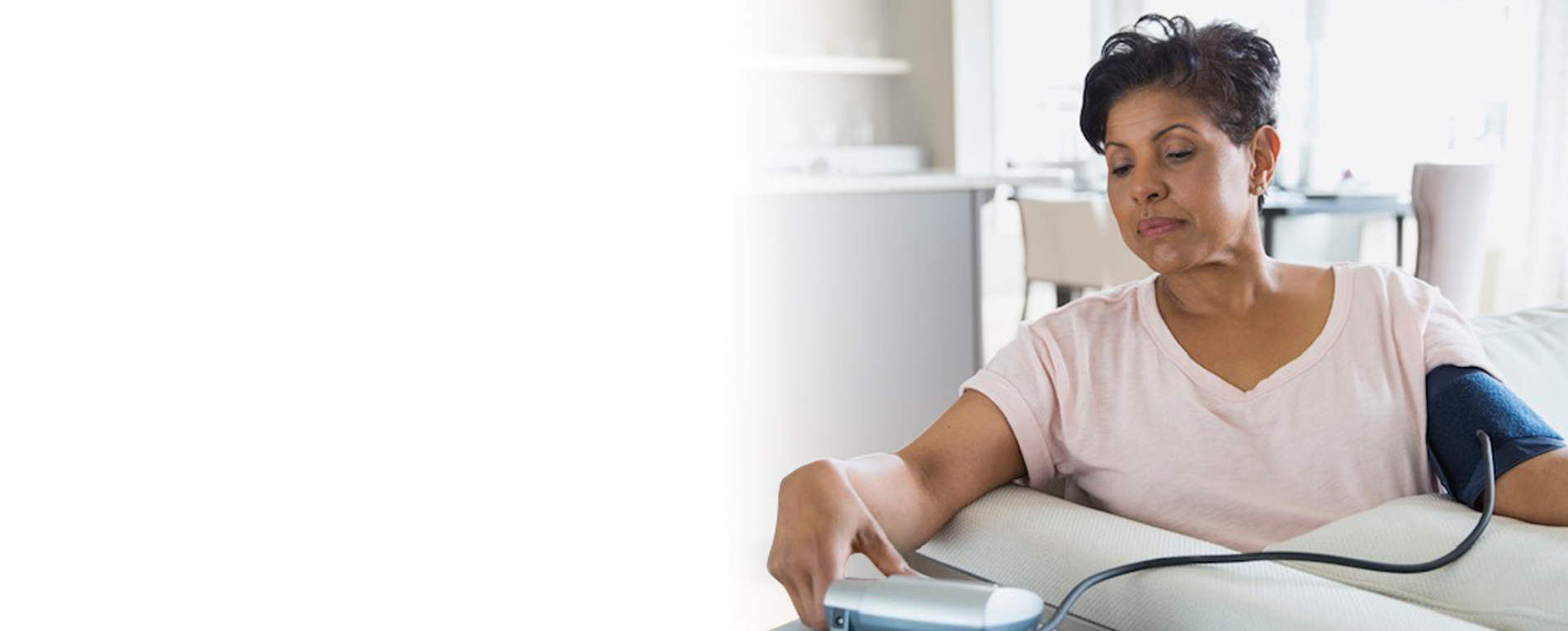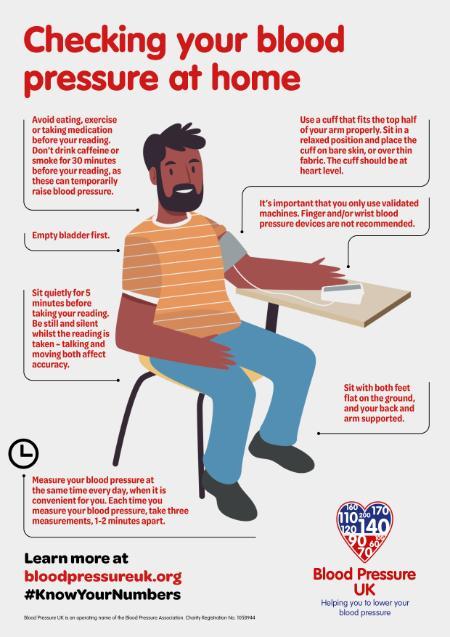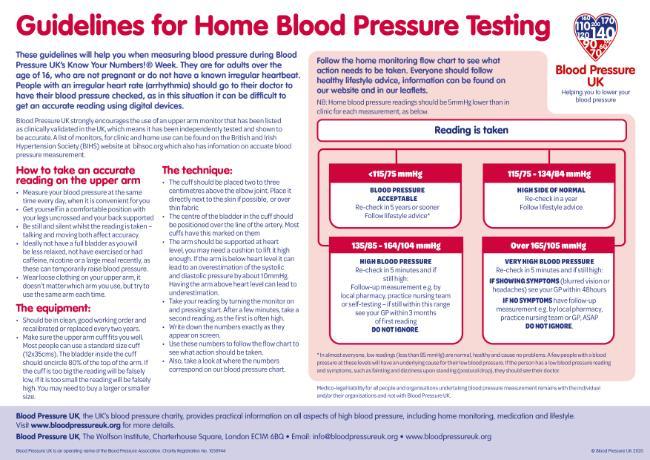How to measure your blood pressure at home.
Welcome to our home monitoring resource hub.
Here you can find resources for home monitoring, see our simple steps to get an accurate reading and make the most out of home monitoring.
Plus, read more about why home monitoring can be helpful and how to choose a monitor.
The first step to managing your blood pressure is to Know Your Numbers! Watch our video to see how to measure your blood pressure at home and use our tips and resources below to check your own blood pressure at home.
Home blood pressure monitoring resources
Download our Checking your blood pressure at home [PDF 113KB] poster and our Guidelines for home blood pressure testing [PDF 44KB] to print and keep at home as a guide.
You can also download our 'Measuring your blood pressure at home' leaflet at the end of the page. This A5 booklet provides clear instructions on how to measure blood pressure at home. It covers how to choose an accurate monitor, how to use the machine correctly at home and when to measure.
Before you measure your blood pressure
- Avoid things that can raise your blood pressure in the short term. Don’t measure your blood pressure within half an hour of eating, smoking, drinking caffeinated drinks such as coffee, or exercising. These can all raise your blood pressure temporarily. If you need to use the toilet, go before you measure your blood pressure.
- Wear loose-fitting clothes. Wear a short-sleeved t-shirt or something with sleeves you can push up easily, nothing tight. This is so that you can fit the cuff around your arm.
- Rest for five minutes before you take your reading. Sit down somewhere quiet, ideally at a desk or table. Have your back supported with your arm resting on a firm surface and your feet flat on the floor. Stay in this position while you take your blood pressure.
- Make sure your arm is supported and at the same level as your heart. Position yourself so that your arm is resting on a surface and is at the same height as your heart. Keep your arm and hand relaxed, not tensed.
- Make sure you are relaxed and comfortable. If you are anxious or uncomfortable, your blood pressure will rise temporarily.
How to measure your blood pressure at home using a home monitor
- Follow the instructions that came with your monitor. Make sure you place the cuff around your arm as described in the instructions.
- Place the arm cuff just above your elbow. The cuff should be about 2cm above your elbow to make sure it can detect the artery in your arm, just under the skin.
- Keep still and quiet while you take your reading. Moving, chewing, talking and laughing can affect your reading. Make sure you don't cross your legs, as this will raise your reading too.
- Take two or three readings, each about one to two minutes apart. If your first reading is much higher than the next, ignore it and take an extra reading. Once you have two to three readings, you can work out the average.
- Keep a record of your measurements. Record all your readings in the memory of your monitor, on your computer or phone or on paper – whichever you prefer. Write them down exactly as they appear on screen.
Tips for measuring your blood pressure at home
- Measure your blood pressure in both arms when you first start. They will give slightly different readings. From then on, use the arm that gave you the higher reading each time.
- Always use the same arm. If possible, use the arm that your doctor or nurse uses when they measure your blood pressure.
- Take readings at the same time each day. For example, first thing in the morning or last thing at night. Your blood pressure can vary throughout the day and with different activities, so this will mean you’re comparing like with like. It’s good to have a routine – like measuring your blood pressure before breakfast.
- Don’t round your measurements up or down. Record your readings as they’re displayed because it could affect the treatment you’re prescribed.
- Don’t worry if you get an unexpected high reading. A one-off high reading is usually nothing to worry about, rest for five minutes and take the reading again. If it’s still high, measure your blood pressure again another day. If it remains high for long, around two or three weeks, see your doctor or nurse.
- Don’t worry about small changes. It’s normal for there to be small changes in your blood pressure.
- Don’t check your blood pressure too often. Some people find that they become worried or stressed about small changes in their readings if they take them too often. Worrying can also raise your blood pressure in the short term, making your reading higher than it should be.
- Don’t stop taking your medications if your blood pressure falls. Always talk to your doctor before stopping your medications, even if your blood pressure has fallen to a healthy level according to your home monitor.
- Speak to your doctor or nurse if you’re worried. If you have doubts or concerns about your readings or home monitoring, speak to your doctor or nurse, or call out healthcare team on 020 7882 6218. If you think you may be having a stroke or heart attack call 999 immediately.
How often should you measure your blood pressure?
When and how often you take your readings will depend on your blood pressure. Speak to your doctor or nurse about what’s suitable for you.
It can be useful to monitor your blood pressure closely to begin with, then less often but at regular intervals.
When you first start using your home monitor
When you first start using a home monitor, measure your blood pressure in the morning and evening, every day for a week.
Take three readings in the morning, one to two minutes apart, and the same again in the evening, and record all the readings. Take an average of the readings, but discard the first one if it’s much higher than the others. To take an average simply add the two readings together and divide by two. Divide by three if you use all three readings.
Ignore the first day’s readings altogether, because they might not be accurate as you’re not familiar with your monitor yet.
At the end of the week you will have a useful picture of what your blood pressure is normally like.
Your doctor might ask you to keep a record like this when they first think you might have high blood pressure and would like to know more before making a diagnosis.
After the first week
Once you have a record of your blood pressure over a week, you can take readings less often – once every one to two weeks perhaps. Your doctor or nurse can talk to you about this, there’s no need to measure it too often.
If your blood pressure has been stable for a long time, you might only need to measure it once every four to six months. Your doctor or nurse will be able to advise you.
There might be times when you want to measure your blood pressure more often. For example, if you are given a new medicine or a higher dose of medicine, to see if the change is having an effect. It’s also helpful to record your numbers for four to seven days before a clinic visit so you can show your doctor.
Keeping a record
Keeping a record will help you and your doctor to see how your blood pressure is responding to treatments and lifestyle changes, and if you need a change in your treatment. Take your record along with you to your appointments.
You can record your readings in the memory of your monitor, on your computer or phone or on paper – whichever you prefer. If you share your monitor with someone else keep a record elsewhere so that your readings don’t get confused.
It’s helpful to keep a diary of your blood pressure readings. Write down all your readings, even the ones you don’t include in the average. Ideally write down the time and date, and the time you took your blood pressure medications. It’s also helpful to note anything that might have affected your blood pressure, for example changes in treatment, episodes of illness, symptoms you have at the time such as headaches or feeling dizzy.
You can also download our handy E-record card [PDF 38KB] below for you to record your blood pressure numbers on. Use our blood pressure chart to see what your numbers mean, and follow our guidelines for home blood pressure testing to see what action you should take.
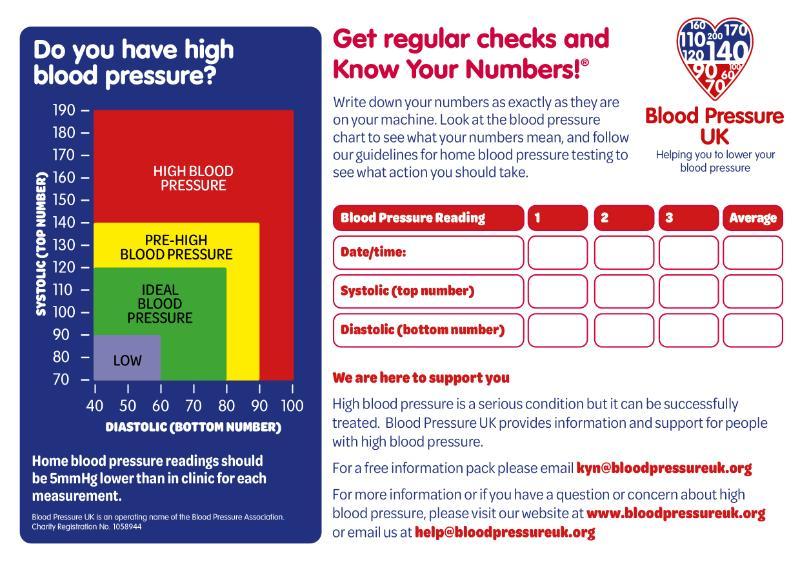
Working with your doctor or nurse
You won’t usually make a decision about treatment based solely on the readings you have taken at home. But they may find it useful to know what you’re blood pressure is like when you’re away from the clinic.
Talk to your doctor or nurse before you start to measure your blood pressure at home. They advise you on when to measure your blood pressure and how often, and this can help you both to be clear about what you are doing and why.
Bring your records with you to your appointments so they can use it to review your treatment.
Make sure your monitor is suitable and you know how to use it
It is a good idea to bring your monitor to the appointment so that your doctor or nurse can check that it is validated and accurate, that it fits properly, and that you know how to use it. They can show you if you’re not sure.
Read more
Learn more about your blood pressure, what blood pressure readings mean, and how to lower your blood pressure.
For further information on home monitoring, download our booklet, Measuring your BP at home [PDF 194KB].
